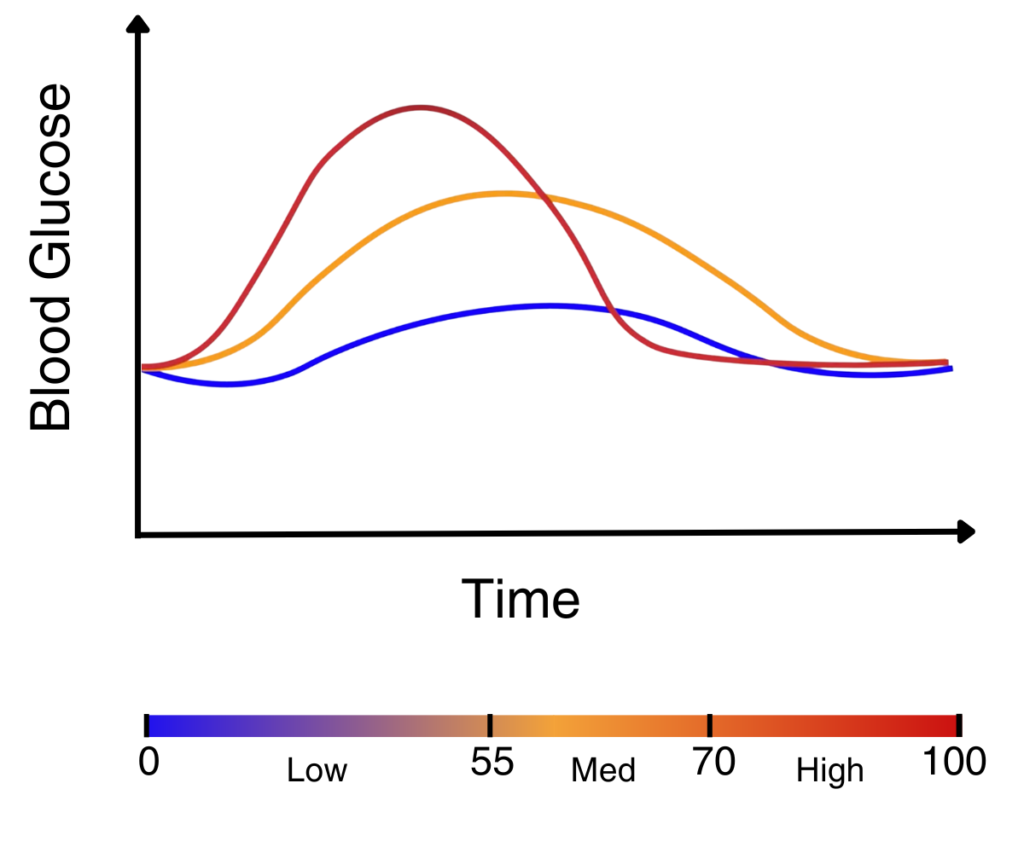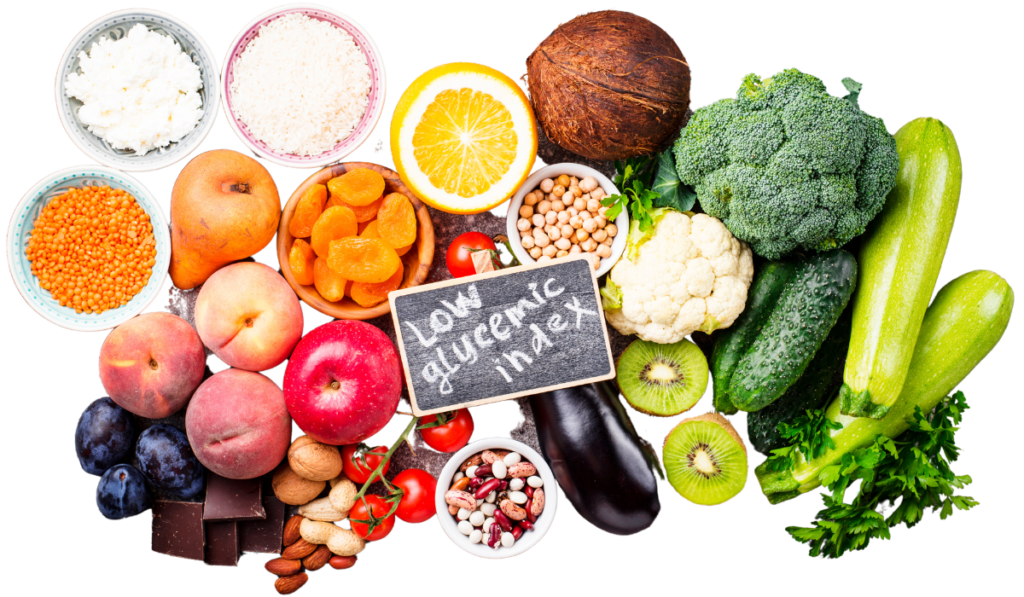
Glycemic Index (GI) of Food May Be Hindering Your Weight loss
Did You Know / Oct 24, 2023 / Comments
Is that plate of pasta a potential blood sugar rollercoaster, or will it keep your energy steady for hours? The answers lie in the glycemic index (GI) and glycemic load (GL) of the foods you eat. These seemingly complex concepts are far more accessible than they first appear and understanding them can significantly impact your health, fitness, and weight loss goals.
Understanding Glycemic Index (GI)
Originally conceived by Dr. David J. Jenkins and his team during the early 1980s, the Glycemic Index (GI) is a quantitative approach that characterizes carbohydrate quality by assessing the glycemic response it induces. According to the Australian Standard (2007) At its core, the GI is a numerical value assigned to foods that reflects how quickly they raise your blood sugar levels compared to consuming pure glucose, which is given a reference score of 100. Low-GI foods have values of 55 or less, while medium-GI foods fall in the 56-69 range. High-GI foods reach 70 or more. The key distinction here is that low-GI foods are more slowly digested and absorbed, resulting in a gradual rise in blood sugar levels over time. In contrast, high-GI foods cause a rapid, sometimes dramatic spike in blood sugar.
As seen in the graph on the right, foods with lower GI and GL have less impact on the blood glucose levels as it’s being digested. This is key in effective weight loss.

Deciphering Glycemic Load (GL)
Where the Glycemic Load (GL) comes into play is in adding a layer of depth to this understanding. It’s a measure that factors in both the quality and quantity of carbohydrates in a serving of food. The GL is a more practical tool for assessing how a specific food impacts your blood sugar in real-world scenarios. For example, even a low-GI food can have a high GL if consumed in large quantities. The methodology in which the GL is calculated is by taking the available carbohydrate grams in a specific food, multiplying this by the food’s GI, and then dividing the result by 100 (Yusof et al., 2020). The Glycemic Load (GL) classification for standardized portions of carbohydrate-rich foods or food products categorizes GL values: ≤ 10 falls into the low GL category, 11 to 19 into the medium GL category, and ≥ 20 is considered a high GL (Eleazu, 2016).
A single GL unit is a close approximation of the glycemic impact of 1 gram of glucose. On average, daily diets consist of around 60 to 180 GL units, but it is recommended that people aim to keep their total daily GL under 100.
In Mathematical terms: GL = GI x available carbohydrates (g)/100 —> where, available carbohydrates = total carbohydrates – dietary fibre
The table below shows some of the common foods consumed daily by people and their GI & GL values. The GL values are calculated based on the average carb portion available in these foods. If you want to look up the GI & GL of specific foods, you can do so here.
| Common Foods | GI | Avg Carb Portion (g) | GL |
|---|---|---|---|
| Apple (Raw) | 44 | 15 | 6.6 |
| Orange Juice | 41 | 15 | 6.15 |
| White Rice (Boiled) | 75 | 45 | 33.75 |
| Brown Rice (Boiled) | 72 | 45 | 32.4 |
| White Bread | 81 | 15 | 12.15 |
| Whole Wheat Bread | 70 | 15 | 10.5 |
| Sweet Potato (Baked) | 91 | 20 | 18.2 |
| Fusili Pasta Twists (Boiled) | 61 | 40 | 24.4 |
Unraveling the Health Implications
Over time, an elevated glycemic response and increased insulin demand can potentially harm the functioning of pancreatic beta cells, resulting in the development of insulin resistance, glucose intolerance, and ultimately increasing the risk of type 2 diabetes substantially (Cersosimo & De Oliveira, 2012). Low-GI and low-GL foods can play a pivotal role in health. They can reduce the risk of developing type 2 diabetes and improve heart health. These foods also provide a sustained source of energy, promoting overall well-being. Additionally, they offer a significant advantage when it comes to controlling your appetite, which can be a valuable asset in managing your weight effectively.

Fitness & GI
For fitness enthusiasts, the GI can influence energy levels during workouts. Low-GI foods are often the preferred choice for activities requiring endurance. They provide a steady and continuous release of energy, ensuring you stay fueled throughout your exercise routine. However, for shorter and more intense exercise sessions, high-GI foods can serve as an energy booster to help you power through.
Certain approaches aimed at enhancing athletic performance draw upon the attributes of carbohydrates and their glycemic index (GI). Research indicates that consuming low GI carbohydrates before exercise promotes favorable changes in plasma glucose and insulin levels, encouraging increased utilization of free fatty acids (FFA), enhanced fat oxidation, and better blood glucose regulation during physical activity (Oosthuyse et al., 2015; Van Can et al., 2012). Conversely, high GI meals prior to exercise appear to reduce fat oxidation and elevate the release of hormones that trigger glycogen breakdown. Lower levels of muscle glycogen are linked to fatigue and a diminished capacity for sustained exercise, which can impact various performance factors, including motivation, fatigue perception, motor skills, and concentration (Febbraio, 2000; Achten & Jeukendrup, 2003).
Its function in Weight Loss/Management
The Glycemic Index and Load are frequently at the center of discussions regarding weight loss and weight management. Low-GI and low-GL foods reduce cravings, making overeating less likely. By maintaining steady blood sugar levels, they diminish the urge for calorie-rich, unhealthy snacks, making it easier to adhere to a well-balanced diet.
In 2014, a study conducted by Juanola-Fagarona et al. was published in the American Journal of Clinical Nutrition. It involved 197 participants who were randomly assigned to 1 of 3 diet groups. The diet groups were the following: low-GI (LGI), high-GI (HGI), and low-fat (LF). Participants’ baseline characteristics did not significantly differ between groups in terms of sex, age, anthropometric measurements, blood pressure, or comorbidities. After six months, the LF-diet group had significantly higher carbohydrate intake and lower fat intake than the HGI- and LGI-diet groups. Additionally, the LGI-diet group had a significantly lower dietary glycemic index (GI) compared to the other groups. In terms of total-body weight loss, all three groups experienced a significant decrease in BMI over the six-month intervention. Between weeks 16 and 24, the LGI-diet group showed greater reductions in BMI compared to the LF-diet group. Changes in BMI were higher in the LGI-diet group than in the LF-diet group after six months.
Parting Thoughts
If you liked this article, you can check out our other Did You Know? articles.
Consider checking out some of our product reviews Dietary Supplements/Diet Plans/Programs & Gear.
If you have any questions, you can contact us here.
